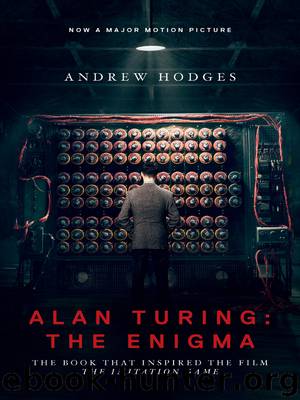Alan Turing: The Enigma: The Book That Inspired the Film The Imitation Game by Andrew Hodges

Author:Andrew Hodges
Language: eng
Format: epub
Publisher: Princeton University Press
Published: 2014-09-15T04:00:00+00:00
* * *
* Wynn-Williams did make some progress, but this machine was probably the work of Keen and BTM.
* There was more than one kind of Robinson: a ‘Peter Robinson’ and a ‘Robinson and Cleaver’ after London department stores, and a ‘Heath Robinson’ after the famous cartoonist specialising in elaborate machines to perform absurdly simple tasks.
* It was from 16 to 22 November 1943.
* Hence the name Rockex, coined by Travis and inspired by that better-known feature of the Rockefeller Center, the Rockettes.
* Technically, of course, there was more to it than this. The speech would first be filtered to remove frequencies above 2000 Hz, and to restrict it to a specific range in amplitude so that it could be described at any point by a number between 0 and I. Then in fact the encipherment was done by adding a continuous key signal first, and then taking the sample by making the resulting speech-plus-key signal modulate a pulse train. The ‘remaindering’ process would then be performed, chopping down a ‘spike’ by one unit if it exceeded one unit in amplitude.
* The output of the ‘orthogonal’ circuit would have the characteristics of random noise in the frequency range up to 2000 Hz. It would be deciphered by performing the sampling process (in strict synchrony, of course, with the sender), and a modular subtraction of the identical key. This would yield the samples of the original speech signal, and it was then a standard procedure, requiring only a low-frequency filter, to recover the speech itself.
* As Alan would stress in explaining the system, this depended crucially upon the use of modular addition. If ordinary unremaindered addition were used, then there would be a correlation between the speech amplitudes and the speech-plus-key amplitudes, and this the cryptanalyst could exploit. Indeed, this is precisely what the ear does in sorting out speech from background noise.
* Fourier theory very naturally involved the use of the ‘complex numbers’, and so did other aspects of the analysis of electronic circuits. The mathematics that he needed was at the undergraduate level – nothing as advanced as the work on the Riemann zeta-function before the war. As with the statistical theory he developed at Bletchley, this was a very good example of how quite elementary nineteenth-century mathematics had applications to the technology of the 1940s that no one had seen, or had tried to see.
* He once expressed himself as shocked by the indiscreet talk at a college dinner of a certain eminent wartime scientist.
* The signal-to-noise ratio was only 10dB, meaning that the speech had only ten times the power of the noise.
* That is, he had arrived at the automatic electronic digital computer with internal program storage. In what follows, the word ‘computer’ will be reserved for machines satisfying all these conditions. But in 1945 the word ‘computer’ meant what it had meant in 1935: either a person who did computations, or any type of machine (in anti-aircraft artillery, for instance) which mechanised that computation. It
Download
This site does not store any files on its server. We only index and link to content provided by other sites. Please contact the content providers to delete copyright contents if any and email us, we'll remove relevant links or contents immediately.
Mastering Bitcoin: Programming the Open Blockchain by Andreas M. Antonopoulos(2931)
Dawn of the New Everything by Jaron Lanier(2699)
Blockchain: Ultimate Step By Step Guide To Understanding Blockchain Technology, Bitcoin Creation, and the future of Money (Novice to Expert) by Keizer Söze(2399)
Alibaba by Duncan Clark(1989)
Foundations of Blockchain by Koshik Raj(1901)
Significant Zero by Walt Williams(1897)
Owning Bitcoin: The Illustrated Guide to Security, Privacy, and Potential by Apodaca Richard(1897)
The Mastermind by Evan Ratliff(1841)
Mastering Blockchain by Imran Bashir(1793)
Bitcoin: The Basics of Blockchain and Investing in Cryptocurrency by K. Connors(1747)
Bitcoin: The Ultimate Guide to the World of Bitcoin, Bitcoin Mining, Bitcoin Investing, Blockchain Technology, Cryptocurrency (2nd Edition) by Ikuya Takashima(1624)
Attack of the 50 Foot Blockchain by David Gerard(1624)
The Bitcoin Standard: The Decentralized Alternative to Central Banking by Saifedean Ammous(1602)
Cryptocurrency by Neil Hoffman(1573)
Shaping the Fourth Industrial Revolution by Klaus Schwab & Nicholas Davis & Satya Nadella(1563)
Turing's Cathedral by George Dyson(1550)
The Bitcoin Guidebook by Ian DeMartino(1547)
Dawn of the New Everything: Encounters with Reality and Virtual Reality by Jaron Lanier(1547)
Bill Gates by Michael Becraft(1492)
